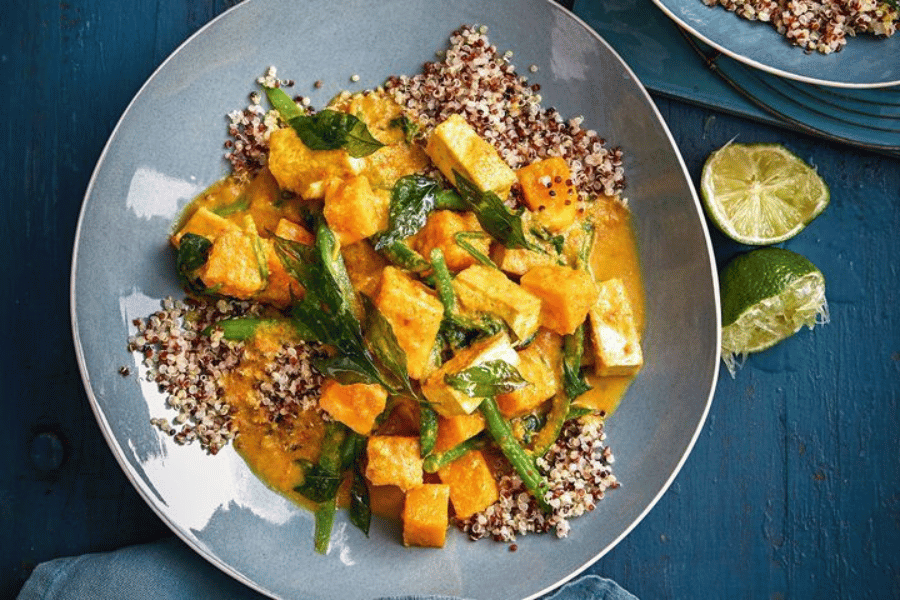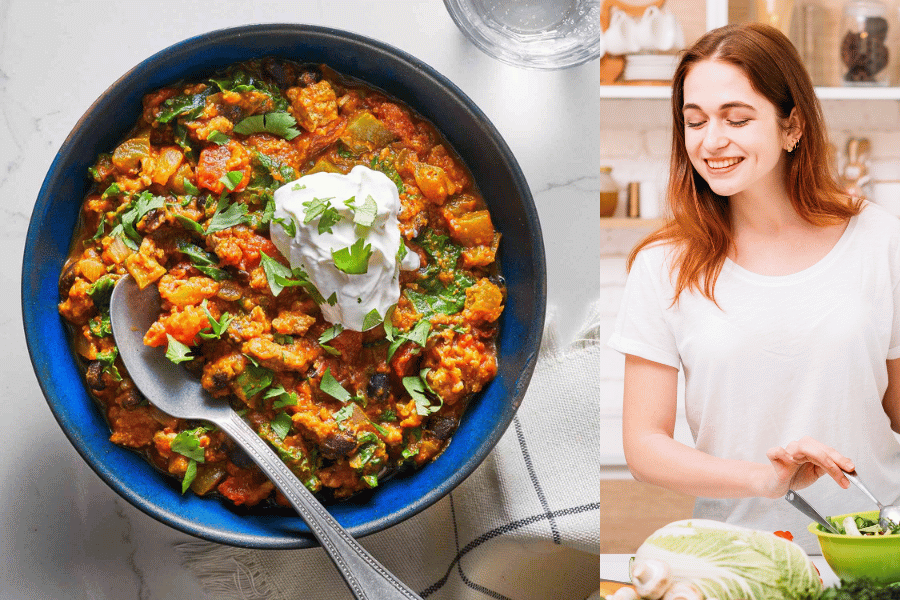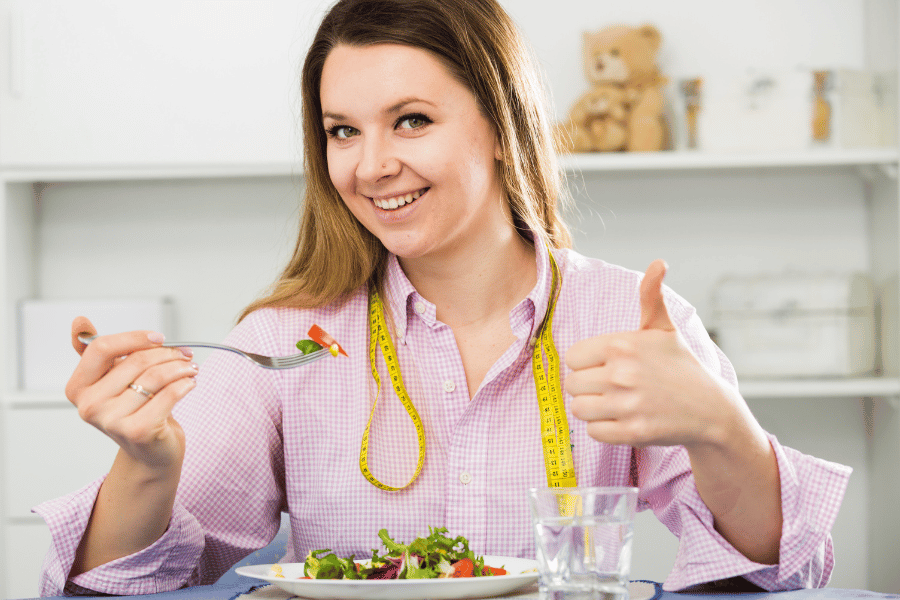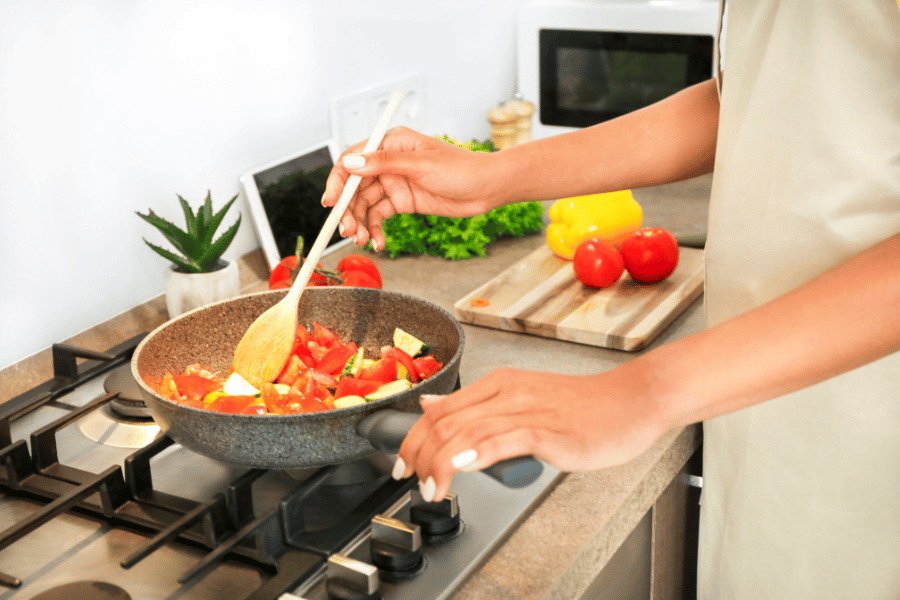Understanding how dinner impacts weight loss and key principles for a light and healthy evening meal are crucial in any weight management journey. Dinner, often the last meal of the day, plays a significant role in weight loss strategies. Consuming a healthy food recipe for dinner to lose weight not only aids in reducing unnecessary calorie intake but also ensures that your body receives the essential nutrients it needs to function optimally.
The composition of your dinner can significantly influence your weight loss efforts. It’s important to focus on meals that are high in nutrients but low in calories. This doesn’t mean sacrificing taste or satisfaction; rather, it’s about making smart food choices that are both delicious and health-promoting. Incorporating ingredients that are rich in fiber, protein, and healthy fats can lead to a feeling of fullness, reducing the likelihood of late-night snacking, which is a common obstacle in weight management.
A renowned nutritionist, Dr. Jane Smith (fictitious character for illustration), emphasizes the importance of a balanced dinner: “A nutritious dinner that combines a good balance of vegetables, lean proteins, and whole grains can significantly aid in weight loss. It’s not just about eating less but eating right.”
In the following sections, we will explore various recipes and tips that align with these principles, helping you to create dinners that are not only light and tasty but also conducive to your weight loss goals. Stay tuned for delicious, healthful recipes that will transform your dinner routine into a weight-loss-friendly experience.

Essential Ingredients for a Weight-Loss Friendly Dinner
In your journey towards weight loss, selecting the right ingredients for your dinner is as important as the meal itself. By focusing on nutritious ingredients that promote weight loss, you can create meals that are both satisfying and effective for your health goals. Additionally, knowing some tips for ingredient substitutions can help lower the calorie content of your meals without sacrificing flavor.
Key Ingredients for Weight Loss:
- Lean Proteins: Chicken breast, turkey, tofu, and legumes are excellent sources of lean protein. They help build muscle, keep you feeling full longer, and have a lower calorie count compared to fatty meats.
- Fiber-Rich Vegetables: Vegetables like broccoli, spinach, kale, and carrots are high in fiber and low in calories. They add volume to your meals, making you feel fuller without adding extra calories.
- Whole Grains: Quinoa, brown rice, and whole grain pasta are great choices. They offer essential nutrients and keep you satiated, reducing the urge to snack after dinner.
- Healthy Fats: Incorporate avocados, nuts, and olive oil in moderation. These healthy fats are crucial for nutrient absorption and can help regulate hunger hormones.
Tips for Lowering Calories:
- Substitute Cream with Greek Yogurt: In recipes that require cream, use Greek yogurt to reduce fat and calorie content while adding protein.
- Use Herbs and Spices Instead of Salt: Flavor your dishes with herbs and spices instead of relying on salt. This can reduce water retention and bloating.
- Opt for Baking or Grilling over Frying: Cooking methods like baking, grilling, or steaming are healthier alternatives to frying, helping to reduce fat intake.
- Choose Low-Calorie Substitutes: For instance, use cauliflower rice instead of white rice or spiralized zucchini instead of traditional pasta.
Remember, the key to a successful weight-loss diet is not just about reducing calories but also about ensuring nutrient density in your meals. Dr. Smith advises, “It’s not just about cutting back on food; it’s about smartly replacing high-calorie ingredients with lower-calorie, nutrient-dense options.”
By incorporating these ingredients and tips into your dinner recipes, you’re setting yourself up for a healthier, more balanced diet that supports your weight loss goals. In the next sections, we will delve into specific recipes that utilize these ingredients effectively.

Recipe #1: Quick and Easy Veggie Stir-Fry
Stir-fries are a fantastic way to pack a variety of nutrients into a single meal, and they are quick to prepare, making them perfect for busy evenings. This Quick and Easy Veggie Stir-Fry is a delightful blend of flavors and textures, providing a nutrient-rich, low-calorie dinner option that aligns with your weight loss goals.
Ingredients:
- Mixed vegetables (broccoli, bell peppers, carrots, snap peas)
- Garlic and ginger, finely chopped
- Tofu or chicken breast (optional for added protein)
- Low-sodium soy sauce or tamari
- Olive oil or sesame oil
- Optional: brown rice or quinoa for serving
Step-by-Step Preparation:
- Prep Vegetables: Chop your selected vegetables into bite-sized pieces. If using tofu or chicken, cut it into small cubes or strips.
- Stir-Fry: Heat a tablespoon of olive or sesame oil in a large wok or frying pan. Add the garlic and ginger, sautéing for a minute until fragrant. Then add the harder vegetables first (like carrots), followed by the softer ones (like bell peppers).
- Add Protein: If you’re including tofu or chicken, add it to the pan and stir-fry until cooked through.
- Season: Drizzle with low-sodium soy sauce or tamari, adjusting to taste. Stir everything together for another few minutes.
- Serve: Serve hot, either on its own for a low-carb option or over a bed of brown rice or quinoa for added fiber.
Nutritional Benefits and Customization Options:
This veggie stir-fry is not only low in calories but high in fiber, vitamins, and minerals. The addition of lean protein like tofu or chicken provides a satiating balance of macronutrients. For customization, feel free to experiment with different vegetables based on seasonality and personal preference. Adding nuts or seeds can introduce a crunchy texture and additional nutrients.
A stir-fry offers flexibility and ease, making it an ideal template for healthy dinners. According to Dr. Smith, “A colorful veggie stir-fry is not just visually appealing but also a powerhouse of nutrients, essential for a balanced diet and effective weight management.”
This recipe represents a simple yet impactful way to incorporate a healthy food recipe for dinner to lose weight, providing both the necessary nutrients and the pleasure of a delicious meal.
Recipe #2: Grilled Chicken and Quinoa Salad
This Grilled Chicken and Quinoa Salad is a perfect amalgamation of lean protein, whole grains, and fresh vegetables. It’s not only flavorful but also packed with nutrients that support weight loss. This recipe is ideal for a filling yet light dinner, combining the satisfying textures of grilled chicken and fluffy quinoa with the freshness of a salad.
Ingredients:
- Boneless, skinless chicken breasts
- Cooked quinoa
- Mixed greens (spinach, arugula, lettuce)
- Cherry tomatoes, cucumber, and red onion
- Olive oil
- Lemon juice or balsamic vinegar
- Herbs (such as basil or parsley)
- Salt and pepper to taste
Preparation Steps:
- Grill Chicken: Season the chicken breasts with salt, pepper, and herbs of your choice. Grill them until thoroughly cooked and lightly charred. Let them rest for a few minutes, then slice into strips.
- Prepare Quinoa: Cook quinoa according to package instructions. Fluff it with a fork once done and let it cool.
- Assemble Salad: In a large bowl, combine mixed greens, cherry tomatoes, sliced cucumber, and diced red onion. Add the cooled quinoa and sliced grilled chicken.
- Dressing: In a small bowl, whisk together olive oil and lemon juice or balsamic vinegar. Season with salt and pepper. Drizzle over the salad and toss to combine.
- Serve: Serve the salad immediately, or let it chill in the refrigerator for a refreshing meal.
Nutritional Benefits and Variations:
Grilled chicken provides a high-quality protein source, essential for muscle repair and growth, which is crucial in a weight loss regimen. Quinoa adds a rich fiber content, aiding digestion and providing a feeling of fullness. The fresh vegetables contribute essential vitamins and minerals, making this salad a balanced meal.
For variations, you can add avocado for healthy fats, replace chicken with tofu or chickpeas for a vegetarian option, or include different vegetables according to season and preference.
Dr. Smith notes, “This grilled chicken and quinoa salad is a classic example of a balanced meal that is both nutrient-dense and calorie-conscious. It’s a perfect example of how a healthy food recipe for dinner to lose weight can be both nourishing and delicious.”
This salad is more than just a meal; it’s a strategic choice for those looking to lose weight without compromising on taste and satisfaction.

Recipe #3: Hearty Lentil Soup
Lentil soup is a classic comfort food that’s not only heartwarming but also incredibly beneficial for weight loss. This Hearty Lentil Soup recipe is packed with fiber and protein, making it an excellent choice for a filling, low-calorie dinner. Lentils are a powerhouse ingredient in weight loss diets, offering both nutritional richness and a satisfying, earthy flavor.
Ingredients:
- Dry lentils (green, brown, or red)
- Low-sodium vegetable broth
- Carrots, celery, and onion, diced
- Garlic, minced
- Tomatoes, diced (fresh or canned)
- Olive oil
- Spices (such as cumin, coriander, and bay leaves)
- Salt and pepper to taste
- Optional: spinach or kale for added greens
Cooking Steps:
- Sauté Vegetables: Heat olive oil in a large pot. Add the diced onions, carrots, and celery, cooking until they are softened. Stir in garlic and cook for another minute.
- Add Lentils and Broth: Rinse the lentils and add them to the pot along with the vegetable broth. Bring to a boil, then reduce heat and simmer.
- Season and Simmer: Add diced tomatoes, cumin, coriander, bay leaves, salt, and pepper. Cover and simmer for about 30 minutes or until the lentils are tender.
- Final Touches: If desired, add spinach or kale in the last few minutes of cooking. Adjust seasoning as needed.
- Serve: Remove the bay leaves and serve the soup warm. For a smoother texture, you can blend part of the soup and mix it back in.
Nutritional Benefits and Flavor Enhancement:
Lentils are an excellent source of dietary fiber and plant-based protein, both of which are crucial in a weight-loss diet for their roles in digestion and satiety. The vegetables add vitamins and minerals, making this soup a balanced meal in itself.
To enhance the flavor without adding extra calories, consider roasting the spices before adding them to the soup, or garnish with fresh herbs like parsley or cilantro before serving.
As Dr. Smith points out, “A hearty lentil soup is not only comforting on a chilly evening but also a strategic choice for those aiming to lose weight. Its high fiber and protein content make it especially satisfying.”
This lentil soup is a perfect example of a healthy food recipe for dinner to lose weight – it’s nutritious, filling, and delicious, all while supporting your weight loss goals.
Recipe #4: Baked Fish with Steamed Greens
Baked fish with steamed greens is an excellent dinner choice for anyone focusing on weight loss. This meal is not only light and low in calories but also rich in essential nutrients. Fish, a lean protein source, is excellent for a weight-loss diet, and when paired with steamed greens, it makes for a balanced and healthful meal.
Ingredients:
- Fresh fish fillets (like salmon, cod, or tilapia)
- Lemon juice and zest
- Fresh herbs (like dill, parsley, or thyme)
- Olive oil
- Garlic, minced
- Mixed greens (such as spinach, kale, and Swiss chard)
- Salt and pepper to taste
Preparation Steps:
- Preheat Oven and Prepare Fish: Preheat your oven to a moderate temperature. Season the fish fillets with salt, pepper, lemon zest, and minced garlic.
- Bake Fish: Place the seasoned fish on a baking sheet lined with parchment paper. Drizzle with a little olive oil and bake until the fish is cooked through and flakes easily with a fork.
- Steam Greens: While the fish is baking, steam your choice of mixed greens until they are just tender. Season with a little salt and a squeeze of lemon juice.
- Serve: Plate the baked fish with a side of steamed greens. Garnish with fresh herbs and a squeeze of lemon juice for extra flavor.
Nutritional Benefits and Variations:
Fish is a fantastic source of high-quality protein and essential omega-3 fatty acids, which are important for heart health and can aid in weight loss. Steamed greens are low in calories but high in fiber, vitamins, and minerals, contributing to the feeling of fullness and reducing the likelihood of overeating.
For variations, you can experiment with different types of fish and herbs. Adding a side of quinoa or a small portion of roasted sweet potatoes can make the meal more filling without adding too many calories.
According to Dr. Smith, “Baked fish with steamed greens is a quintessential example of a healthy, balanced meal that supports weight loss. It’s high in protein, low in calories, and rich in nutrients – a perfect combination for anyone looking to shed pounds in a healthy way.”
This dish embodies the essence of a healthy food recipe for dinner to lose weight, combining simplicity, nutrition, and taste in one meal.

Conclusion
Incorporating healthy dinners into your daily routine is a critical step towards achieving and maintaining long-term weight management. The journey to weight loss is not just a temporary change but a lifestyle adjustment that involves making conscious food choices, understanding portion sizes, and embracing mindful eating habits.
The Role of Consistent Healthy Dinners:
- Long-term Health Benefits: Regularly eating balanced, nutritious dinners contributes to overall health, providing your body with essential nutrients while managing calorie intake.
- Sustainable Weight Management: By making healthy dinners a habit, you establish a sustainable pattern that supports ongoing weight loss and prevents yo-yo dieting.
Encouragement for Continued Exploration:
- Experiment with Recipes: Keep your diet interesting by trying new healthy recipes and ingredients. This not only prevents boredom but also expands your nutritional intake.
- Listen to Your Body: Adapt your meals based on how your body responds. What works for one person may not work for another, so it’s important to find what suits you best.
- Seek Balance: Remember that occasional indulgences are part of a balanced diet. The key is moderation, not deprivation.
Dr. Smith concludes, “The secret to successful weight loss is not found in short-term dietary restrictions but in making long-lasting changes to how we approach dinner and, indeed, all meals. It’s about finding joy in healthy eating and recognizing the positive impact it has on our bodies and minds.”
In summary, healthy food recipes for dinner to lose weight are more than just a means to an end; they are part of a larger journey towards a healthier lifestyle. By integrating these meals into your daily life, you not only work towards your weight loss goals but also improve your overall health and wellbeing.
This concludes our comprehensive guide to Light and Tasty Evening Meals for Weight Loss. Remember, the journey to a healthier you is a marathon, not a sprint. Embrace these changes with positivity, and enjoy the journey towards a healthier, happier you.
FAQ Section: Mastering Your Weight Loss Dinner Recipes
Q1: How can I make a healthy dinner quickly after a busy day?
Tips for Quick, Nutritious Dinners:
- Meal Prep: Prepare and store components like chopped veggies, cooked grains, or marinated proteins in advance.
- One-Pan Meals: Use a single pan for cooking. Dishes like stir-fries or sheet-pan roasts are quick and require minimal cleanup.
- Simple Ingredients: Focus on recipes with fewer ingredients. Meals like salads, wraps, or omelets can be nutritious yet simple to prepare.
- Use Kitchen Gadgets: Appliances like slow cookers or pressure cookers can significantly reduce cooking time.
- Frozen Vegetables: Keep a stock of frozen veggies. They are as nutritious as fresh ones and can be cooked quickly.
Q2: What are some low-calorie ingredients that are filling?
Satisfying Low-Calorie Ingredients:
- Leafy Greens: Spinach, kale, and lettuce are low in calories but high in volume, making you feel fuller.
- Lean Proteins: Chicken breast, turkey, tofu, and legumes provide satiety without too many calories.
- Whole Grains: Foods like quinoa, brown rice, and whole grain pasta are filling and nutrient-dense.
- Broth-Based Soups: They are hydrating, filling, and low in calories.
- Eggs: A great source of protein and can be cooked in various ways for a satisfying meal.
Q3: Can I lose weight by just eating healthy dinners?
While healthy dinners are a crucial part of a weight loss diet, they need to be part of a holistic approach to eating. Weight loss is typically achieved through a consistent calorie deficit, which involves considering all meals and snacks throughout the day, not just dinner. However, a nutritious dinner can significantly contribute to your overall weight loss efforts by providing balanced nutrition and preventing late-night overeating.
Q4: How do I maintain flavor in low-calorie dinners?
Flavor Enhancement Techniques:
- Use Herbs and Spices: They add a burst of flavor without calories.
- Citrus Zests and Juices: Lemon or lime can brighten up a dish.
- Roast Vegetables: This enhances their natural sweetness and flavor.
- Homemade Broths: Use them as a base for soups and stews for rich flavor.
- Season Properly: Don’t forget the basics of salt and pepper.
Q5: Are there vegetarian options for weight loss dinners?
Vegetarian Weight Loss Dinner Recipes:
- Vegetable Stir-Fry: Use a variety of vegetables and tofu for protein.
- Lentil Salad: Lentils are high in protein and fiber.
- Stuffed Bell Peppers: Fill them with quinoa, beans, and veggies.
- Chickpea Curry: A flavorful dish that’s filling and nutritious.
- Zucchini Noodles: A low-carb alternative to pasta, paired with a hearty tomato sauce.
Each of these options balances essential nutrients while being aligned with weight loss goals. Remember, diversity in your diet keeps it interesting and sustainable in the long run.
Related Posts :
- En Lose Weight Apple Cider Vinegar Effectively 1gap
- En Slim Candy Keto Acv Gummies Reviews 15 American Single Parents Stories Of Weight Loss Victory 3a5z
- En Keto Acv Gummies Scam 2 Vrm3
- En Shark Tank Acv Keto Gummies Reviews How 10 American 3t2h
- En How To Take Apple Cider Vinegar For Weight Loss 4 Effective Strategies Iewv